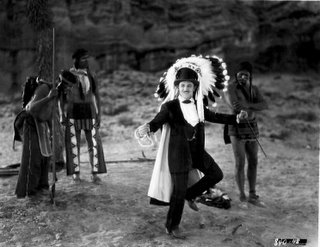'Hands Up!': The Other Silent Griffith

Someone did me a great favor at the end of last year. I was all set to write a letter nominating the 1926 comedy Hands Up! to the National Film Registry, when lo-and-behold, Hands Up! actually turned up on the 2005 list of new additions. We hope this will ensure that this sadly underappreciated film will now have resources devoted to its preservation, and that my former teacher David Shepard will finally convince Paramount to release it on DVD.
The film's creator, silent comedian Raymond Griffith (no relation to D.W.) was born on this day in 1890 in Boston. Griffith -- who came from a theatrical family and had appeared on stage since infancy -- entered films in 1914 and learned his craft at the knee of Mack Sennett. Unlike most of the frantic comedians of Sennett's school, however, Griffith's comic persona was understated, even debonair -- he wore a neatly trimmed moustache and slicked hairstyle in the manner of the leading men of the day, and most often could be found wearing a top hat and opera cape -- and he derived his laughs principally from his grinning, sardonic nonchalance, cunning sleight-of-hand and dry comic timing.
Most of his feature films are lost, but the best of the ones that survive, Hands Up! (1926), is an irreverant comic gem about a confederate spy during the Civil War. Although it pales by the inevitable comparison to Buster Keaton's masterpiece, The General, another comic tale about the Civil War told from the point of view of the South, Hands Up! is an edgier film which dared (in a more innocent age) to depict and poke fun at Abraham Lincoln and his cabinet, Robert E. Lee and his command center, gambling on Indian reservations and Mormon polygamy. (The latter moment, the film's closing gag, was often cut by censors.) Griffith's dexterity is as smooth as silk, which contributes to the astonishing transformations that provoke some of the film's biggest laughs -- in which a firing squad with one flick of the wrist becomes a skeet shooting competition, or an Indian war dance, with one swift kick, becomes an exhibition of the Charleston.
As the venerable Kerr points out, Griffith's reputation as a taskmaster unfortunately gave rise to the notion that he was a self-centered bully when it came to the production of comedy -- but watching Hands Up! conveys a different story. Some of the best laughs come from Griffith's supporting performers, including Mack Swain (who Yosemite-Sam's his way through the dusty landscape of the film) and Virginia Lee Corbin, the dimmer of Swain's two daughters.
Griffith's last on-screen appearance was as a dying soldier in All Quiet on the Western Front (1930), which is a little like Greg Kinnear suddenly showing up as a corpse in an episode of CSI. Well, a little like that. The coming of the talkies effectively ended Griffiths's on-screen career, his voice reduced to a hoarse whisper by an old injury to his vocal chords (as a boy, he apparently shrieked so violently while performing a scene in The Witching Hour on stage that his voice never fully recovered), but he switched to film producing for Fox studios, putting his stamp on swashbucklers, musicals and adventure films during the 1930s. He died on November 25, 1957 at the Masquers Club in Los Angeles, having choked on some food.
"Griffith seems to me to occupy a handsome fifth place -- after Chaplin, Keaton, Lloyd, and Langdon -- in the silent comedy pantheon, a place that is his by right of his refusal to ape his contemporaries and his insistence on following the devious curve of an entirely idiosyncratic eye." -- Walter Kerr.
Labels: Silent Film





0 Comments:
Post a Comment
Subscribe to Post Comments [Atom]
<< Home